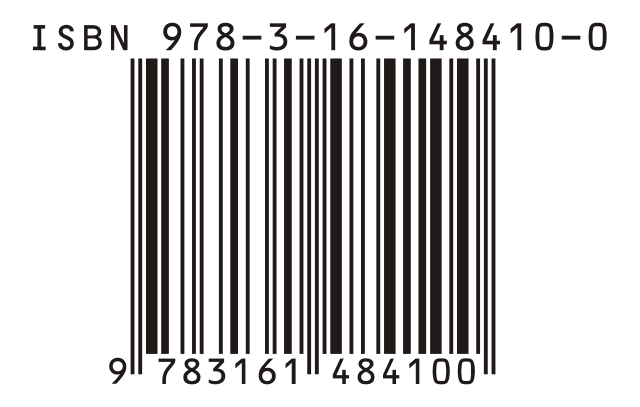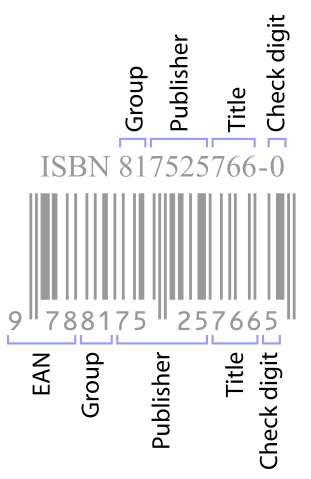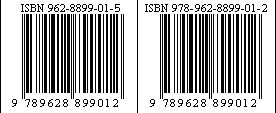ISBN and Bar Code Technology - A Visit to the Book Industry
Hi Dear Steemians. Welcome once again to my blog! I hope you’re doing great, right? No? It is weekend fam! So, what else? It’s time to put off the stress of the week into something fun. As for me, I would be starting my weekend by attending a conference with international executives of the American Society of Heating, Refrigerating, and Air-Conditioning Engineers (ASHRAE). What about you?
I would like to begin with a little announcement that the topic of today might at one point begin to get hot, so I urge you to reseat and prepare yourself before reading this post as some crazy numbers are going to appear and you might lose count! (maybe it’s just my opinion though)
The last time, I introduced the Bar Code Technology to us here. I believe you have seen it, have you? If not, I don’t think I can take you out for lunch. So, make your choice!
The Bar Code Technology is an optically powered set of numbers, lines or shapes that represents uniquely - a product, in a graphical manner. It stores the product’s data which is then retrieved using a Bar Code reader which optically read the represented data in form of the Bar Code.
Lost already? I warned! Didn’t I?
But, is it actually complicated? Maybe I am the dumb one here!
The fact that the Bar Code Technology is found almost everywhere sexily caught my fancy and pushed me to start oiling my brain, knowingly, with an excess of its knowledge. But guys, guess what? There’s now a spillage!
I can’t seem to hold it in all by myself anymore and of course, I just must share the excess with you!
Demeaning? Nah! My excesses are as well rich! So definitely, this isn’t going to be pointless as mass effect 3’s multiple endings! (Did I hear a “Silicon Valley” mate shout wow?).
What am I even saying? Excesses? Yeah! Excesses of Bar Code Technology knowledge that led me to pitiably soak myself in researching about ISBN!
Now, I’m full and I inevitably have to pass some excesses with you in this post. Trust me, you won’t be same afterwards! So, kindly accept my apology from here, if at all, I force your brain to learn something new (Charity, right? I am just like that – naturally philanthropic)
So, can we just proceed? Who needs your permission?!

What is ISBN? Don’t you want to know?
ISBN is simply an acronym for International Standard Book Number. Its origin can actually be traced using a mtDNA to its senior, SBN - Standard Book Number (@fololade taught me that in her post about Mitochondrion DNA some days ago. I just hope I’m not a bad student!).
ISBN is a unique numeric book identifier that is usually assigned to commercially published books. For a particular book with different variations like an e-book, paperback or hardcover format, unique ISBN is usually assigned to each of these copies regardless of the fact that it is same work having same title and content.
The concept of ISBN is directed towards commercially published books. So, privately published books don’t necessarily need an ISBN, unless in a scenario where they are jealous. Blaming it? Aren’t you jealous of my talents too? Just tell me.
So, what brought about ISBN, what happened?
Well, the Book Industry has for long been a unique and continuous one as new and newer book are being printed every day. These books, the old and new remains in the market and could be ordered anytime. Therefore, a means of identifying them is needed so that it can be easy to request for them at any time.
As far back as the early 1960s, publishers still had to do with the vague self-numbering style for identifying books they publish. But as time passed, they began to find a way to improve accountability, efficiency and profitability. They needed an automated way of generating book identifiers that would be a standard and comprehensive one.The idea first stem in the UK when WH Smith announced their decision to move from manual to a computerized warehousing system within two years. This birthed the idea of the 9-digit standard book number (SBN) system developed by Gordon Forster for publications identification.
Its immediate success led to interests from other publishing agencies like RR Bowker from the US, national libraries and other bibliographical agencies from countries like Sweden, Denmark, Canada and many more.
This arising international presence of the book numbering style led to the addition of a “0” prefix to the SBN, forming the popular ISO auspicated 10-digit Standard number that was used from then until the last day of 2006 when the International Organization for Standard (ISO) later introduced the 13-dight ISBN system. This new system is being prefixed by an additional 3-digit GS1 (Global Standard one) number to the previous 10-digit number system and the adopted style till date.
I hope it’s not getting complicated yet, that’s what I had to face reading it too (sorry) and forgive me if my brief history doesn’t give you that deep and adventurous feel a historian could have given you.

ELEMENTS OF ISBN
As earlier said, the 13-digit book number system – an improvement on the previously used 10-digit book numbering style, is the system in operation. This numbering system is generated by appending some prefixes to the old Gordon Forster’s 9-digit book numbering system and hence, it is nice to help us understand how these new numbering systems work. If you’d be patient like I was, then why not, you could learn some math too.
Basically, in an ISBN-10 system, there are four elements making up the numbers while the ISBN-13 system is made of five elements. In the ISBN-10 system, we have;
- The Registration group element
- The Registrant Element
- The Publication Element (Title element)
- The Check Digit
The fifth part of that makes up the 13-digit system is the GS1 prefix element which is usually a 3-digit number in line with the EAN "Bookland" country code. These number elements are then written together separated by a hyphen or in some cases spaces to make a unique book number for each book format.
The Registration Group Element
The Registration Group Element identifies the publisher’s place of business - his country or geographical region or the language of the book being published. It is usually a five-digit number assigned in descending order of the publishing volume. It usually follows the structures;
0-5, 7;
600-649;
80-94;
950-989;
9900-9989;
99900-99999
In terms of language, some single digits identifiers under the 978-prefix element have been assigned to some countries.
The numbers 0 and 1 have been assigned for English-speaking countries, 2 has been assigned for French-speaking countries; 3 for German-speaking countries; 4 for Japan; 5 for Russian-speaking countries; and 7 for People's Republic of China.
Also, within the 979-prefix element, some numbers have been assigned to some particular country. The numbers 10, 11 and 12 have been assigned to France, Republic of Korea, and Italy respectively.
Did anyone understand at all? Since I did, why won’t you? I haven’t said anything gibberish, have I? So, let’s continue
The Registrant Element
The Registrant element is simply the part of the ISBN structure that identifies the Publisher. Each publisher is assigned a registrant number and a series of ISBNs within the same registrant element by the national ISBN agency.
These set of assigned ISBNs is used to identify a particular publisher’s publications and serves as an imprint. It can be up to 7 digits and varies for different publishers and registration groups.
The Publication Element (Title element)
This element of the ISBN is used to identify the edition or format of a particular publication or a specific title. It can be up to 6 digits in length.
As said earlier, regardless of the similarity in the title of a publication, each of its format either the hardcover, paperback, e-book or others will be assigned its own ISBN and this variation for each publication or specific title is being indicated in the Publication element section of the ISBN structure.
The Check Digit
This is the fixed one digit usually found on the end part of the ISBN. It is usually generated from the other number as a way to mathematically validate the remaining numbers. It is used for error detection and is the decimal equivalent of a binary check bit.
The check digit is usually calculated using the Modulus 11 system for the ISBN-10 Digit system while the Modulus 10 is used for the ISBN-13 Digit system.
Aren’t you gonna ask how that is done? You wanna run from the mathematics shit, right? I’m sorry to tell you that you can’t escape that. So, draw a seat and learn!
ISBN-10 Modulus System calculation for the Check Digit
The modulus 11 system involves the calculation of the check digit such that the sum of all the 10 digits, with each multiplied by its integer position weight when descending from 10 to 1, is a multiple of 11. I know, I know, it is difficult, I didn’t get it easily that way either (you are probably smarter though). So, take a chill pill, I sure would expatiate on that.
Let’s take an example using the Willmann–Bell ISBN - 0-943396-04-2. Here, we will try to get through how the check digit 2 is gotten. Do you have your pen yet? Quickly do and let’s learn some math (proud teacher):
Let,
S = Sum of the product of the 10 digits and their integer position weight
X1 – X10 = the 10 digits
Therefore,
S = 10 X1 + 9X2 + 8X3 + 7X4 + 6X5 + 5X6 + 4X7 + 3X8 + 2X9 + X10.............…(1)
From the Willmann–Bell ISBN 0-943396-04-2, we know that X1– X9 = 0, 9, 4, 3, 3, 9, 6, 0, and 4, therefore, eqn(1) becomes:
S = 10(0) + 9(9) + 8(4) + 7(3) + 6(3) + 5(9) + 4(6) + 3(0) + 2(4) + X10
S = 0 + 81 + 32 + 21 + 18 + 45 + 24 + 0 + 8 + X10
S = 229 + X10
So, our Check digit, X10 must be such that 229 + X10 is a multiple of 11. So, looking up the multiplication table, we would see that the next multiple of 11 is 231. Therefore, we have:
229 + X10 = 231
X10 = 231 – 229
X10 = 2
This affirms the check digit 2 used in the Willmann–Bell ISBN 0-943396-04-2.
I know you want to tell me I’m the best teacher already, but, wait, let’s do the ISBN-13 check digit calculations. Then, you can bring my award already
ISBN-13 Modulus System calculation for the Check Digit
The modulus 10 system involves the calculation of the check digit such that the sum of all the 13 digits is a multiple of 11, with each digit progressively multiplied by 1 and 3 interchangeably. Crazy, right? But, remember, I am a genius teacher! So, let’s do this together again!
Taking the ISBN- 13, 978-3-16-148410-0 as an example, we seek to get the check digit “0” from the calculation.
Let,
S = Sum of the product of the 13 digits and their integer position weight
X1 – X13 = the 13 digits
Therefore,
S = X1 + 3X2 + X3 + 3X4 + X5 + 3X6 + X7 + 3X8 + X9 + 3X10 + X11 + 3X12 + X13 ..........(2)
We know that X1 – X12 = 9, 7, 8, 3, 1, 6, 1, 4, 8, 4, 1, and 0. So eqn(2) becomes:
S = 9 + 3(7) + 8 + 3(3) + 1 + 3(6) + 1 + 3(4) + 8 + 3(4) + 1 + 3(0) + X13
S = 9 + 31 + 8 + 9 + 1 + 18 + 1 + 12 + 8 + 12 + 1 + 0 + X13
S = 110 + X13
So, our Check digit, X13 must be such that 110 + X13 is a multiple of 10. From our answer, we can see that 110 is already a multiple of 10, so it is the multiple we seek. Therefore, we have:
110 + X13 = 110
X13 = 0
This affirms the check digit “0” used in the ISBN-13, 978-3-16-148410-0 as the right one.
Where’s my award already? Don’t I deserve it?

ISBN AND BARCODING
So, as I narrated earlier, the interest in the Bar Code Technology led me here talking about ISBN. Haven’t you been thinking whether there exists a correlation or not? Well, whether you’ve or not, I am going to tell you, PERIOD!
Both systems are used for easy identification and are usually uniquely assigned. I said earlier that the Bar Code Technology represents data in a graphical manner using numbers, lines or other shapes.The Bar Code Technology is used on books by storing the ISBN along with other details like price, size, weight or any other in form of lines and numbers and can be easily used as a means of identifying the book in case of cataloguing, inventory or sale.
The 13-digit ISBN system is used in Bar Coding as it matches the EAN-13 that is usually incorporated into the 10-digit ISBN system. So, it is easier and needs o conversion to the EAN format as it is already a 13-digit system already.
The Bar-coding helps the publishers to keep track of sale of their books and increases profitability and efficiency.

ELIGIBLE AND INELIGIBLE PRODUCTS FOR ISBN ASSIGNMENT
As you must have noted (if you’re not dumb like me), not all products are eligible for ISBN assignment especially the privately published works or regularly updated works. So, to avoid obscurity or evade the claim that I am a bad teacher for not telling you which of your works to seek ISBN for, I’ll just list them here below
Eligible Products
These simple include products that are monographic, text-based and public. These includes:
- Digital publications like E-books that are online for downloads
- Printed books
- Educational films, videos or DVDs available to the public
- Maps and Atlases
- Art-books with a Title page
- Microform Publications
- Audiobooks available to the public
Ineligible Products
Works that are susceptible to frequent or periodical update are the major set of ineligible work for ISBN assignment. They include:
- Journals
- Newspapers
- Art-books without a title
- Abstract of works
- Games
- Digital Bulletin
- Customized Books for personal use
- Greeting cards
- Videos or DVDs that aren’t intended for educational usage
Well, take those, for now, I have tried. However, don’t hesitate to find out about others if I haven’t mentioned it. Thanks for helping my lazy-self do some research.

PRINCIPLE OF ASSIGNMENT OF ISBN
Another important thing is the placement of the ISBN on the desired work. As the main objective is identification, where do you think is best for the ISBN placement? Your vault or doorway? I know many of you keep a lot of valuable thing in highly protected places but buddy, this even as valuable it is, needs to be seen, so kindly drop your vault’s lock key in my DM (discord not steemit), let me help you out!
Well, for ISBN placement, especially when in Bar Code format should be placed where it can be easily scanned during transactions or inventory purpose. So, the following are the preferred placement position for some works;
- Printed Books
The copyright page or the foot of the title page of the book should carry the ISBN especially when it is in bar-code format. If not, it can be placed on the back cover
- Digital Publications
The title page or simply the first page or screen should carry the ISBN for digital works like compact disks, eBook and so on.
- Eligible Educational Videos or films
In educational works in video formats, the credit titles should carry the ISBN
- Publication inside a container
For publications in which the container is an integral part, the ISBN should be placed any label included on the container or simply the back or side of the container.

BENEFITS OF ISBN
After all, I’ve said so far, you still expect me to tell you the benefits? Don’t you think you can list that yourself already? But I know, not everyone can be as smart as I am. So, I would just without pride again give out information about that.
The use of ISBN in the book industry is significant and has been a groundbreaking discovery which makes Book inventory system an easier to operate. Also, libraries and bookstores find it very helpful in making their functions easier and more efficient. So, the benefits of ISBN assignment to products includes:
- It makes ordering and distribution of books easy to do
- It is required for operation of Point of Sale in Bookstores
- It allows for clarification of different versions of a particular product especially when it is in different formats and foams
- It is a unique identifier that replaces the old and tedious bibliographical descriptive records
- It is an internationally applicable standard and makes a purchase of any book across different countries easier.
Need I say more?

CONCLUSION
The system of Bar Coding is a great technology that makes every business easier to operate in terms of tracking and monitoring sales, easy inventory and records. The concept of ISBN also makes the unique industry of Book and other publications and enjoyable one to do.
I believe we enjoyed this a bit, at least the “easy” math part. Thanks for staying till the end, I would have run if I was the reader too.
Trust me, I am a genius. So, believe all I said!

LITTLE TASK
I love it when my readers feed me back on my posts. So, for this post, I'll like to hear from you on the following
- How much significance do you think the ISBN has in the book industry?
- Can every publication be assigned an ISBN?
- To my attentive students (don't get it twisted, I meant readers), can you help provide the Check digit for these ISBNs: 978-81-7525-766-X, 1-55615-678-X
Thanks for your time

REFERENCES
• ISBN Agency
• Wikipedia | International Standard Book Number
• 10 Things You Should Know About the ISBN
• ISBN Agency | History
• Wikipedia | List of Registration group identidier
If you write STEM (Science, Technology, Engineering, and Mathematics) related posts, consider joining #steemSTEM on steemit chat or discord here. If you are from Nigeria, you may want to include the #stemng tag in your post. You can visit this blog by @stemng for more details.





Congratulations @mrbreeziewrites! You have completed some achievement on Steemit and have been rewarded with new badge(s) :
Click on any badge to view your own Board of Honor on SteemitBoard.
To support your work, I also upvoted your post!
For more information about SteemitBoard, click here
If you no longer want to receive notifications, reply to this comment with the word
STOPVery nice article sir, i have not actually looked at the ISBN codes this way.
However, concerning your questions, i think I'll pass!
Thanks for stopping by.
LOL. What happened to the Questions? I believe you're smarter than my dumb self..
I hope you try it and tell the answer.
And the award for teacher of the year goes to @mrbreziewrites (hope you are happy now)
You kind of answered my comment on your previous post with this scintillating and explicitly written article.
I will see you at the conference.
Thanks!!!! At last, someone acknowledged my ingenuity. I am proud of this achievement!!
Exactly! Thanks for stopping by once again.
Chai... This mathematics looks hard sir. I will have to take my time to solve this so i can understand how this isbn works.
I never knew them to be this complex all i thought is that its just an identification number for a book or something. Thanks for the education.
It's actually not...
Try to follow the examples I did.... If you've know of binary number system conversion, you should ace it
Wow... I was even thinking today how these ISBN are created.
And i came across this post.
Thanks so much for the knowledge
I appreciate your time. Happy I'm able to impact something...
Your Post Has Been Featured on @Resteemable!
Feature any Steemit post using resteemit.com!
How It Works:
1. Take Any Steemit URL
2. Erase
https://3. Type
reGet Featured Instantly & Featured Posts are voted every 2.4hrs
Join the Curation Team Here | Vote Resteemable for Witness